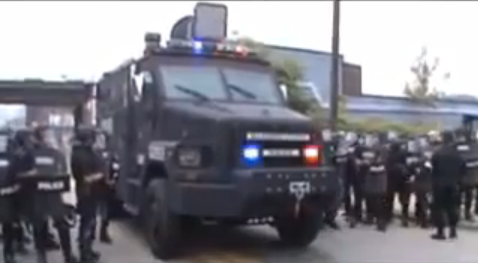 Pittsburgh police demonstrated the latest in crowd control techniques on protesters when they used “sound cannons” to blast the ears of citizens near the G-20 meeting of world economic leaders. City officials said this was the first time such sound blasters, also known as “sound weapons,” were used publicly.
Pittsburgh police demonstrated the latest in crowd control techniques on protesters when they used “sound cannons” to blast the ears of citizens near the G-20 meeting of world economic leaders. City officials said this was the first time such sound blasters, also known as “sound weapons,” were used publicly.
Lavonnie Bickerstaff of the Pittsburgh Bureau of Police uses benign language like “sound amplifiers,” and “long-range acoustic device” to explain the new weapons in an attempt to sanitize what is essentially a painful weapon that leaves no visible marks on its victims. The mob utilized a similar tactic on snitches when they would beat everywhere except the face. If victims have no outward bruises to show, the world is less likely to believe their stories of assault and harassment.
Unlike aerosol hand-grenades, pepper spray, and rubber bullets (all traditional methods of protest suppression also used at the G-20 protests,) the damage from sound cannons is entirely internal, and can only be preserved on video, but even then, the deafening noise cannot be fully appreciated unless one hears it in person.
(Footage of the sound cannons in action can be seen/heard below. It’s clear from these videos that the extremely loud, high-pitched noise causes pain.)
The “long range acoustic device (LRAD)” is designed for long-range communication and acts as an “unmistakable warning,” according to the American Technology Corporation (ATC,) which develops the instruments. “The LRAD basically is the ability to communicate clearly from 300 meters to 3 kilometers” (nearly 2 miles), said Robert Putnam of American Technology’s media and investor relations during an interview with MSNBC. “It’s a focused output. What distinguishes it from other communications tools out there is its ability to be heard clearly and intelligibly at a distance, unlike bullhorns.”
Except, police aren’t trying to send a distress call to allies 2 miles away. They’re literally blasting this extreme decibel of noise directly into the ears of protesters (or any unwitting citizens) standing mere feet from the cannons. Depending on the mode of LRAD, it can blast a maximum sound of 145 to 151 decibels — equal to a gunshot — within a 3-foot (one meter) range, according to ATC. The National Institutes of Health (NIH) reports that permanent hearing loss can result from sounds at about 110 to 120 decibels in short bursts or even just 75 decibels if exposure lasts for long periods.
But there is a volume knob, Putnam notes, so its output can be less than max, purportedly to give us comfort in the knowledge that deafening citizens is left to the discretion of power-hungry police. On the decibel scale, an increase of 10 (say, from 70 to 80) means that a sound is 10 times more intense. Normal traffic noise can reach 85 decibels, reports MSNBC, but these sound cannons cannot be compared to standing beside a busy New York City road.
The BBC reported in 2005 that the “shrill sound of an LRAD at its loudest sounds something like a domestic smoke alarm, ATC says, but at 150 decibels, it is the aural equivalent to standing 30m away from a roaring jet engine and can cause major hearing damage if misused.”
This technology has been deployed in Iraq as an “anti-insurgent weapon,” and the sonic weaponry is also being used on protesters in Honduras. Seattle Weekly reports that this weapon could easily be used as a torture tool if one doesn’t already think this is its only use.
Sonic weaponry is now being deployed domestically to put a chill on free speech. We’re told this is the “humane” way to deal with protesters, but it’s really just a convenient way to suppress citizens without the messy aftereffects of having to explain bullet holes to reporters. A bunch of protesters complaining about ruptured ear drums doesn’t make for dramatic news.